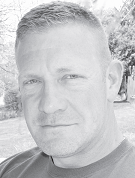
Chris Cerino is a nationally known firearms instructor who has been training law enforcement officers and military for more than 10 years. He will now be writing a monthly “Training Tips” column for The Gun Mag.com. He has worked in law enforcement positions for municipal, county, state and federal agencies spanning 19 years. A majority of those years have been spent in tactical and firearms related fields. His skills are founded in life experience. Literally immersed in pistol training, finding new ways to get shooters to feel comfortable and perform to strict standards is what made Chris the shooter and instructor that he is today. He is the director of training for Chris Cerino Training Group LLC. Teaching the importance of fundamentals in a “do as I do” fashion is what has caused him to be a respected instructor across the country. Chris remains immersed in the firearms industry by teaching and competing nationwide.
by Chris Cerino
“My daddy says…” I wish I had a dollar for every time I’ve heard that line from a shooter in need of serious help. Everything from Daddy says, “Let the gun recoil,” or “just use the tip of your finger.” Let’s focus on the “tip of the finger” line. I know a little bit about pulling triggers and have made some great shots. I enjoy taking any gun and getting hits no matter what type of trigger it has.
One thing I have to tell you is that I don’t just use the tip of my finger.
With all the different triggers out there and all the different people and hand sizes, any one trigger finger placement is impossible.
When teaching, I use a variety of descriptions to bring visuals to a shooters mind. One of my favorites is walking down a staircase. Think of a good trigger as a well built staircase in which every step has an even 7- inch rise. A staircase like that takes very little effort to walk down, and each step does not jar the body as the treads are close to your foot as you go down. That visual would coincide with a good two-stage AR15 trigger of maybe 4.5 pounds.
Next, think of a single stage AR15 trigger devoid of all natural greases or oils. In my mind I see a staircase with steps that have a 20-inch rise! Every step, or trigger pull, is a bone jarring landing that makes it impossible to make a well aimed precision shot. I know that a good solid grip does much to compensate for a poor trigger pull, but should I need to squeeze the heck out of a gun so I keep from moving the sights?
Trigger finger placement
A 4.5-pound trigger is probably going to get the center of the first pad of my finger. A single stage 8-pound gritty trigger is going to get all the way up to the first joint. No kidding! How would you soften the landing on those 20-inch stair rises? No railings to hold on to. I would probably drag the back of my calf down the face of the stair tread so my landing would be softer. Think of sneaky, quiet movement down the stairs. I could apply this idea to my trigger finger by getting more finger into the trigger and by even dragging some of my finger along the lower inside trigger guard.
All but the finest tuned guns have some amount of creep in the trigger movement. I was teaching a class the other day and one man had an S&W revolver. The triggers are a long stroke but very smooth and don’t seem to stack or get heavier as you squeeze. He would touch the trigger with the tip of his finger, press a little then snap the trigger the rest of the way. I showed him that maybe he should put more than the tip of his finger in there so as not to wear out his finger and gain more control. He did this and began squeezing the trigger. He happened to have a laser on his gun so as we dry fire practiced; he immediately noticed how much less his muzzle moved when the hammer fell. He was shooting 8- inch plates out to 50 feet consistently with live fire drills. All because of trigger finger placement.
So, when you get a new gun in your hand and are inspecting it for all the things you look for in a gun, don’t just point it and dry fire it. Remember, your brain can only do so many things at one time. After you have verified both visually and physically that the gun is empty, try this technique.
Point the gun in a safe direction and close your eyes. Squeeze the trigger trying to feel every bit of movement in the trigger and visualize that movement as you do this. Visualize every detail from finger contact with the trigger to coming through the slack in the first stage to the pressure wall of the second stage. After the first stage, feel how the trigger weight stacks or doesn’t. How much pressure does it take to begin moving the trigger rearward? Feel for any hitches, sticky or gravelly movements. Sometimes it’s just that the mechanisms are poorly lubricated.
Feel for the hammer to fall or sear to disengage. Do this several times so that you can become familiar or “intimate” with the gun. After feeling the trigger you could try dry firing with a sight picture and sight alignment to see how the gun is influenced by the trigger squeeze. From there I would try a variety of trigger finger placements on that particular trigger to attempt to cause less influence on sight alignment and sight picture as I squeezed the trigger. You can never truly shoot to your potential trying to apply a one-finger-placement-fits-all trigger squeeze.
Until next time.
Those who can, do. Those who understand, teach.



